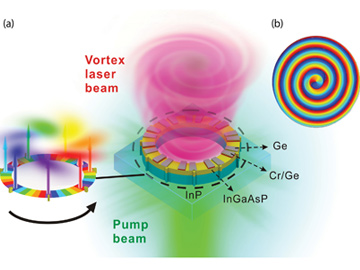 (a) Schematic of OAM microlaser. (b) Simulated phase distribution of laser radiation. The electric-field phase changes by 2π upon one full circle around the center of the vortex. The phase is continuous everywhere except for the center of the emission path, presenting a topological phase singularity point at the beam axis. [P. Miao et al. Science 353, 464 (2016). Reprinted with permission from AAAS.]
(a) Schematic of OAM microlaser. (b) Simulated phase distribution of laser radiation. The electric-field phase changes by 2π upon one full circle around the center of the vortex. The phase is continuous everywhere except for the center of the emission path, presenting a topological phase singularity point at the beam axis. [P. Miao et al. Science 353, 464 (2016). Reprinted with permission from AAAS.]
A light beam that carries orbital angular momentum (OAM)1 possesses helical phase fronts; therefore, the Poynting vector within the beam is twisted with respect to the principal axis. Considering this unbounded degree of freedom, OAM beams are viewed as candidates for encoding information to address the exponentially growing demand for network capacity. Schemes for generating complex OAM beams have thus far all been passive, depending on either bulk devices or recently developed planar optical components. Realizing a miniaturized optical-communications platform, however, requires developing independent micro- and nanoscale laser sources that emit complex vector beams with OAM information.
We recently demonstrated a microlaser that produces a single-mode OAM vortex beam, with the ability to precisely define the topological charge of the OAM mode.2 Through the combined index and gain/loss modulations at an exceptional point, we break mirror symmetry in the lasing-generation dynamics and facilitate unidirectional power oscillation in a microring resonator. At the exceptional point, the Fourier transform of the implemented complex refractive-index modulation is one-sided, yielding one-way distributed feedback.3,4 The result is a robust, unidirectional laser emission above the laser threshold.
Such unidirectional laser operation allows full phase access from 0 to 2π, versus the typically quantized phase at either 0 or π in a laser cavity. This, in turn, allows on-demand wavefront shaping of laser radiation. In particular, by strategically designing the sidewall scatters corresponding to the phase along the microring perimeter,5 the radiation is successfully extracted upward in free space to form a vortex laser beam. We have observed efficient and stable single-mode OAM lasing with a side-mode suppression ratio of approximately 40 dB.
In our view, this integrated OAM microlaser—producing a single-mode optical vortex beam with an on-demand topological charge—could offer novel degrees of freedom for the next generation of optical communications in both the classical and quantum regimes.
Researchers
P. Miao, Z. Zhang, J. Sun, W. Walasik, N.M. Litchinitser, and L. Feng, State University of New York, Buffalo, N.Y., USA
S. Longhi, Politecnico di Milano and Istituto di Fotonica e Nanotecnologie del Consiglio Nazionale delle Ricerche, Milano, Italy
References
1. L. Allen et al. Phys. Rev. A. 45, 8185 (1992).
2. P. Miao et al. Science 353, 464 (2016).
3. Z. Lin et al. Phys. Rev. Lett. 106, 213901 (2011).
4. L. Feng et al. Nat. Mater. 12, 108 (2013).
5. X. Cai et al. Science 338, 363 (2012).

